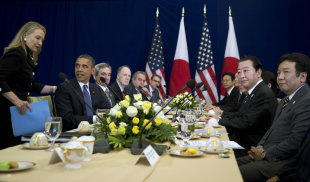THE HAGUE, Netherlands (AP) — The International Criminal Court unsealed an indictment Thursday against former Ivory Coast President Laurent Gbagbo‘s wife on charges including murder, rape and persecution. It was the first time in the court’s 10-year history it has charged a woman.
The world’s first permanent war crimes tribunal said the arrest warrant was issued on Feb. 29 for former first lady Simone Gbagbo for crimes against humanity.
Her husband, Laurent Gbagbo, is already in custody at the court’s detention unit in The Hague facing similar charges stemming from his fight to retain power after losing a 2010 presidential election. If his wife is extradited, they could face justice together in an unprecedented husband-wife trial.
But a senior member of Ivory Coast President Alassane Ouattara‘s government, who requested anonymity because he wasn’t authorized to speak to the media, said Ivory Coast has already informed the ICC that the nation will not let her go.
“We informed them of this a long time ago,” he said.
The court’s chief prosecutor, Fatou Bensouda, urged Ivory Coast to extradite Gbagbo.
“The type of crimes committed in the aftermath of the 2010 elections did not happen by chance — they were planned and coordinated at the highest political and military levels and all those bearing the greatest responsibility must be held to account,” Bensouda said in a statement.
She said prosecutors continue to investigate crimes committed by both sides in Ivory Coast’s bloody power struggle and expect to issue further arrest warrants in the future.
“The investigations are objective, impartial and independent, and are conducted in strict accordance with the law,” she said.
Ivory Coast officials are holding the 63 year old under house arrest in the northwest town of Odienne. Last week, Ivorian prosecutor Noel Dje Enrike Yahau said lawyers had questioned Simone Gbagbo there for two days and that the domestic charges against her remained the same: genocide, blood crimes and economic crimes.
Unsealing the ICC arrest warrant issued nearly nine months ago appears to be a tactic by the court to put pressure on Ouattara’s administration to hand over Ms. Gbagbo.
If authorities in Ivory Coast want to prosecute her, they have to convince judges at The Hague tribunal that their case involves the same crimes she is charged with at the ICC. It is a court of last resort, meaning it only takes cases from countries unwilling or unable to prosecute them.
The international court said in the warrant that there is evidence pro-Gbagbo forces deliberately attacked perceived supporters of Ouattara in the aftermath of the election.
Judges who reviewed evidence supporting the charges against Ms. Gbagbo said they found “there are reasonable grounds to believe that Ms. Gbagbo bears individual criminal responsibility for the crimes … as ‘an indirect co-perpetrator.’”
The warrant called Gbagbo an “alter ego for her husband” with the power to make state decisions. It said there is evidence to suggest she “instructed the pro-Gbagbo forces to commit crimes against individuals who posed a threat to her husband’s power.”
Her husband was the first former head of state to be taken into custody by the court when he was extradited to The Hague by the Ivory Coast government last year.
Prosecutors say about 3,000 people died in violence by both sides after Gbagbo refused to concede defeat following the election. Ouattara finally took power in April 2011 with the help of French and U.N. forces.
Ivory Coast is not a member state of the court, but has voluntarily accepted its jurisdiction.
It is very rare for a woman to be charged by an international war crimes court. In the past, the Yugoslav war crimes tribunal convicted former Bosnian Serb President Biljana Plavsic of persecution and sentenced her to 11 years imprisonment.
The announcement of the arrest warrant and Ivory Coast’s refusal to hand over Gbagbo appeared likely to raise tensions between supporters of her husband and those who back Ouattara.
Moussa Toure Zeguen, a leader of the Gbagbo allies in exile in Ghana, said by phone from Accra that the former president’s supporters had no faith in the Ivorian authorities to give Simone Gbagbo a fair trial.
“We don’t trust them. The only thing that Ouattara is doing is revenge,” Zeguen said. “He wants to try us without trying any of the fighters from his side who also committed crimes. It is not fair, and this cannot bring reconciliation.”
____
Associated Press writers Rukmini Callimachi in Dakar, Senegal, and Robbie Corey-Boulet in Abidjan, Ivory Coast, contributed to this report.
Europe News Headlines – Yahoo! News











